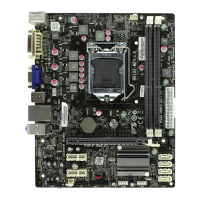
Do you have a question about the ECS H61H2-M2 and is the answer not in the manual?
| Memory slots type | DIMM |
|---|---|
| Number of memory slots | 2 |
| Supported memory types | DDR3-SDRAM |
| Maximum internal memory | 16 GB |
| Supported memory clock speeds | 1066, 1333 MHz |
| Processor socket | LGA 1155 (Socket H2) |
| Processor manufacturer | Intel |
| Compatible processor series | Intel Celeron, Intel Pentium |
| Maximum number of SMP processors | 1 |
| Power fan connector | Yes |
| Number of SATA connectors | 4 |
| Number of Parallel ATA connectors | 0 |
| HDMI ports quantity | - |
| USB 2.0 ports quantity | USB 2.0 ports have a data transmission speed of 480 Mbps, and are backwards compatible with USB 1.1 ports. You can connect all kinds of peripheral devices to them. |
| Audio chip | VIA VT1705 |
| Certification | RoHS |
| Component for | PC |
| Power source type | ATX |
| Motherboard chipset | Intel® H61 |
| Audio output channels | 5.1 channels |
| Motherboard form factor | micro ATX |
| Compatible operating systems | Windows 7 32-bit/64-bit |
| Parallel processing technology support | Not supported |
| PCI Express slots version | 2.0 |
| Networking features | Fast Ethernet |
| BIOS type | AMI |
| BIOS memory size | 32 Mbit |
| Supported storage drive interfaces | SATA II |
| Depth | 180 mm |
|---|---|
| Width | 225 mm |
Welcomes user and introduces the H61H2-M2 motherboard and its target market.
Details key features of the CPU socket, chipset, memory support, and audio capabilities.
Lists comprehensive technical specifications for CPU, memory, expansion slots, I/O, etc.
Identifies and labels the physical components and connectors on the motherboard.
Essential safety guidelines for handling and installing the motherboard to prevent damage.
Guides on selecting a compatible computer case based on form factor and I/O template.
Instructions for physically mounting the motherboard into a computer case.
Explains how to correctly set jumpers for motherboard configuration and CMOS clearing.
Step-by-step procedure for installing the CPU into the LGA1155 socket.
Instructions for inserting DDR3 memory modules into the DIMM slots.
Guide on installing expansion cards into PCI Express slots.
Details on connecting internal headers like front panel audio, USB, COM, SPDIF.
Instructions for connecting SATA hard drives using SATA cables.
Explains how to connect external devices to the motherboard's rear I/O ports.
Instructions for connecting internal case components like power buttons, LEDs, and fans to motherboard headers.
Introduces the BIOS Setup Utility, its functions, and how it stores configurations.
Lists keyboard keys and their functions for navigating and operating the BIOS setup utility.
Describes the BIOS main menu, displaying basic system information and navigation options.
Covers system configuration settings for CPU, LAN, storage, USB, and other advanced features.
Monitors system hardware health, including voltages, temperatures, and fan speeds.
Provides options to configure SATA modes (e.g., IDE) and manage SATA port settings.
Allows enabling or disabling USB devices and configuring legacy USB support.
Settings related to System Agent, PCH, and ME configurations for chipset behavior.
Options for setting clock speeds, bus speeds, and CPU overclocking parameters.
Configures the system's boot priority and NumLock state at startup.
Options for setting administrator and user passwords to protect BIOS access.
Options for saving configuration changes, exiting setup, or restoring defaults.
Step-by-step guide for downloading and safely installing BIOS updates from the manufacturer.
Details the contents of the support software disc, including drivers and utilities.
Explains the convenient auto-installation process for drivers and software.
Procedures for installing drivers manually if the auto-install feature is not functional.
Information on available utility software and their licensing terms.
Addresses initial PC startup issues like no power or no display after assembly.
Solutions for startup failures occurring after the system has been in use for some time.
Provides basic advice on maintaining the motherboard to ensure longevity and performance.
A visual guide to diagnose and resolve common hardware problems systematically.
